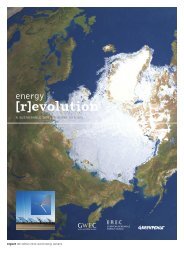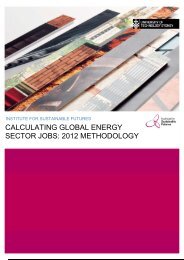download the mexico energy revolution scenario
download the mexico energy revolution scenario
download the mexico energy revolution scenario
Create successful ePaper yourself
Turn your PDF publications into a flip-book with our unique Google optimized e-Paper software.
table 2.5: renewable power for non-oecd countries under ftsm programme<br />
ELECTRICITY<br />
GENERATION<br />
(TWh/a)<br />
Wind E[R]<br />
PV E[R]<br />
Biomass E[R]<br />
Geo<strong>the</strong>rmal E[R]<br />
Solar Thermal E[R]<br />
Ocean Energy E[R]<br />
Total - new RE E[R]<br />
Wind adv E[R]<br />
PV adv E[R]<br />
Biomass adv E[R]<br />
Geo<strong>the</strong>rmal adv E[R]<br />
Solar Thermal adv E[R]<br />
Ocean Energy adv E[R]<br />
Total - new RE adv E[R]<br />
2007<br />
23.6<br />
0.2<br />
41.2<br />
21.6<br />
0.0<br />
0.0<br />
86.7<br />
23.6<br />
0.2<br />
41.2<br />
21.6<br />
0.0<br />
0.0<br />
86.7<br />
2015<br />
307.0<br />
22.0<br />
218.0<br />
50.5<br />
21.7<br />
4.6<br />
623.8<br />
312.0<br />
22.0<br />
218.0<br />
55.4<br />
24.7<br />
4.6<br />
636.7<br />
2020<br />
854.5<br />
105.4<br />
488.5<br />
111.0<br />
112.1<br />
27.4<br />
1,699.0<br />
1,092.0<br />
204.0<br />
487.0<br />
164.0<br />
281.0<br />
67.0<br />
2,295.0<br />
2030<br />
2,238.0<br />
673.0<br />
950.0<br />
251.0<br />
798.0<br />
48.5<br />
4,958.5<br />
2,949.0<br />
998.0<br />
946.0<br />
715.0<br />
1,550.0<br />
237.0<br />
7,395.0<br />
INSTALLED<br />
CAPACITY<br />
(GW)<br />
image CHECKING THE SOLAR PANELS<br />
ON TOP OF THE GREENPEACE POSITIVE<br />
ENERGY TRUCK IN BRAZIL.<br />
Wind E[R]<br />
PV E[R]<br />
Biomass E[R]<br />
Geo<strong>the</strong>rmal E[R]<br />
Solar Thermal E[R]<br />
Ocean Energy E[R]<br />
Total - new RE E[R]<br />
Wind adv E[R]<br />
PV adv E[R]<br />
Biomass adv E[R]<br />
Geo<strong>the</strong>rmal adv E[R]<br />
Solar Thermal adv E[R]<br />
Ocean Energy adv E[R]<br />
Total - new RE adv E[R]<br />
2007<br />
15<br />
0<br />
7<br />
4<br />
0<br />
0<br />
26.2<br />
15<br />
0<br />
7<br />
4<br />
0<br />
0<br />
26.2<br />
2015<br />
138<br />
14<br />
44<br />
9<br />
9<br />
1<br />
214.1<br />
140<br />
14<br />
44<br />
10<br />
10<br />
1<br />
218.1<br />
2020<br />
347<br />
59<br />
100<br />
19<br />
36<br />
8<br />
570.7<br />
443<br />
114<br />
100<br />
28<br />
91<br />
20<br />
795.1<br />
© GP/FLAVIO CANNALONGA<br />
2030<br />
865<br />
383<br />
173<br />
44<br />
130<br />
14<br />
1,610.3<br />
1,142<br />
560<br />
173<br />
117<br />
255<br />
70<br />
2,316.2<br />
2<br />
implementing <strong>the</strong> <strong>energy</strong> [r]evolution | GREENHOUSE DEVELOPMENT RIGHTS<br />
2.3 greenhouse development rights<br />
The Energy [R]evolution <strong>scenario</strong>s present a range of pathways<br />
towards a future based on an increasing proportion of renewable<br />
<strong>energy</strong>, but such routes are only likely to be followed if <strong>the</strong>ir<br />
corresponding investment costs are shared fairly under some form<br />
of global climate regime. To demonstrate how this would be possible<br />
we have used <strong>the</strong> Greenhouse Development Rights framework,<br />
designed by EcoEquity and <strong>the</strong> Stockholm Environment Institute,<br />
as a potential basis for implementing <strong>the</strong> Energy [R]evolution .<br />
Greenpeace advocates for industrialized countries, as a group, to<br />
reduce <strong>the</strong>ir emissions by at least 40% by 2020 (as compared to<br />
1990 emissions) and for developing countries, as a group, to reduce<br />
<strong>the</strong>ir emissions by at least 15% by 2020 as compared to <strong>the</strong>ir<br />
projected growth in emissions. On top of <strong>the</strong>se commitments<br />
Greenpeace urges industrialized countries to provide financial<br />
resources of at least $US140 billion per year to fund <strong>the</strong> cost of<br />
climate change mitigation and adaptation in developing countries.<br />
The Greenhouse Development Rights framework provides a tool for<br />
distributing both this emission reduction and finance target equally<br />
amongst countries. Below we show how this will work for<br />
implementing <strong>the</strong> Energy [R]evolution <strong>scenario</strong>s.<br />
<strong>the</strong> greenhouse development rights framework<br />
The Greenhouse Development Rights (GDR) framework calculates<br />
national shares of global greenhouse gas obligations based on a<br />
combination of responsibility (contribution to climate change) and<br />
capacity (ability to pay). Crucially, GDRs take inequality within<br />
countries into account and calculate national obligations on <strong>the</strong><br />
basis of <strong>the</strong> estimated capacity and responsibility of individuals.<br />
Individuals with incomes below a ‘development threshold’ –<br />
specified in <strong>the</strong> default case as $7,500 per capita annual income,<br />
PPP adjusted – are exempted from climate-related obligations.<br />
Individuals with incomes above that level are expected to contribute<br />
to <strong>the</strong> costs of global climate policy in proportion to <strong>the</strong>ir capacity<br />
(amount of income over <strong>the</strong> threshold) and responsibility<br />
(cumulative CO2 emissions since 1990, excluding emissions<br />
corresponding to consumption below <strong>the</strong> threshold).<br />
The calculations of capacity and responsibility are <strong>the</strong>n combined<br />
into a joint Responsibility and Capacity Indicator (RCI) by taking<br />
<strong>the</strong> average of <strong>the</strong> two values. Thus, for example, as shown in Table<br />
2.6 below, <strong>the</strong> United States of America, with 4.5% of <strong>the</strong> world’s<br />
population, has 35.8% of <strong>the</strong> world’s capacity in 2010, 36.8% of<br />
<strong>the</strong> world’s responsibility and 36.3% of <strong>the</strong> calculated RCI. This<br />
means that in 2010, <strong>the</strong> USA would be responsible for 36.3% of<br />
<strong>the</strong> costs of global climate policy.<br />
Because <strong>the</strong> system calculates obligations based on <strong>the</strong><br />
characteristics of individuals, and all countries have at least some<br />
individuals with incomes over <strong>the</strong> development threshold, GDRs<br />
would eliminate <strong>the</strong> overarching formal distinction in <strong>the</strong> Kyoto<br />
Protocol between Annex I and non-Annex I countries. There would<br />
of course still be key differences between rich and poor countries,<br />
as rich countries would be expected to pay for reductions made in<br />
o<strong>the</strong>r countries as well as making steep domestic emissions<br />
reductions, while poor countries could expect <strong>the</strong> majority of <strong>the</strong><br />
incremental costs for emissions reductions required within <strong>the</strong>ir<br />
borders to be paid for by wealthier countries. Similarly, <strong>the</strong> national<br />
obligations calculated through GDRs could be used to allocate<br />
contributions to a global adaptation fund; again, even poor<br />
countries would have some positive obligations to contribute, but<br />
<strong>the</strong>y would expect to be net recipients of adaptation funds, while<br />
rich countries would be net contributors.<br />
25



![Energy [R]evolution - European Commission](https://img.yumpu.com/49109324/1/184x260/energy-revolution-european-commission.jpg?quality=85)


![5905 gp [eu rev]csfr4.qxd - Energy [R]evolution](https://img.yumpu.com/42305023/1/184x260/5905-gp-eu-revcsfr4qxd-energy-revolution.jpg?quality=85)


![5905 gp [eu rev]csfr4.qxd - Energy [R]evolution](https://img.yumpu.com/28729264/1/184x260/5905-gp-eu-revcsfr4qxd-energy-revolution.jpg?quality=85)